
Spectacles of Pageantry, Worship, and Vengeful Spirits
Guideto Japan
Culture- English
- 日本語
- 简体字
- 繁體字
- Français
- Español
- العربية
- Русский
Matsuri Origins
Kyoto’s Gion Matsuri, Osaka’s Tenjin Matsuri, and Tokyo’s Kanda Matsuri are considered Japan’s three most famous festivals. All take place in large cities, attracting hundreds of thousands, or even millions, of spectators drawn by the pure spectacle and the special matsuri atmosphere. Gorgeous floats, boisterous groups carrying mikoshi portable shrines, traditional music and dance, and long histories have earned each of these festivals their reputations as notable events.
The three festivals share a common origin, having begun as a means of appeasing vengeful spirits—the souls of people who met violent or untimely deaths and who have come back to haunt the living and exact revenge by inflicting various misfortunes on them. Heian period (794–1185) scholar, poet, and statesman Sugawara no Michizane (845–903) is celebrated at Osaka’s Tenjin Matsuri, and Tokyo’s Kanda Matsuri honors Taira no Masakado (903–940). These historical personages were deified to appease their angry spirits. Kyoto’s Gion Matsuri, meanwhile, reveres Gozu Tennō, a syncretic deity wreaking havoc on humankind, whose fearsome powers were harnessed to ward off plagues and epidemics.
Gion Matsuri
(July 1–31, Higashiyama-ku, Nakagyō-ku, Shimogyō-ku, Kyoto)
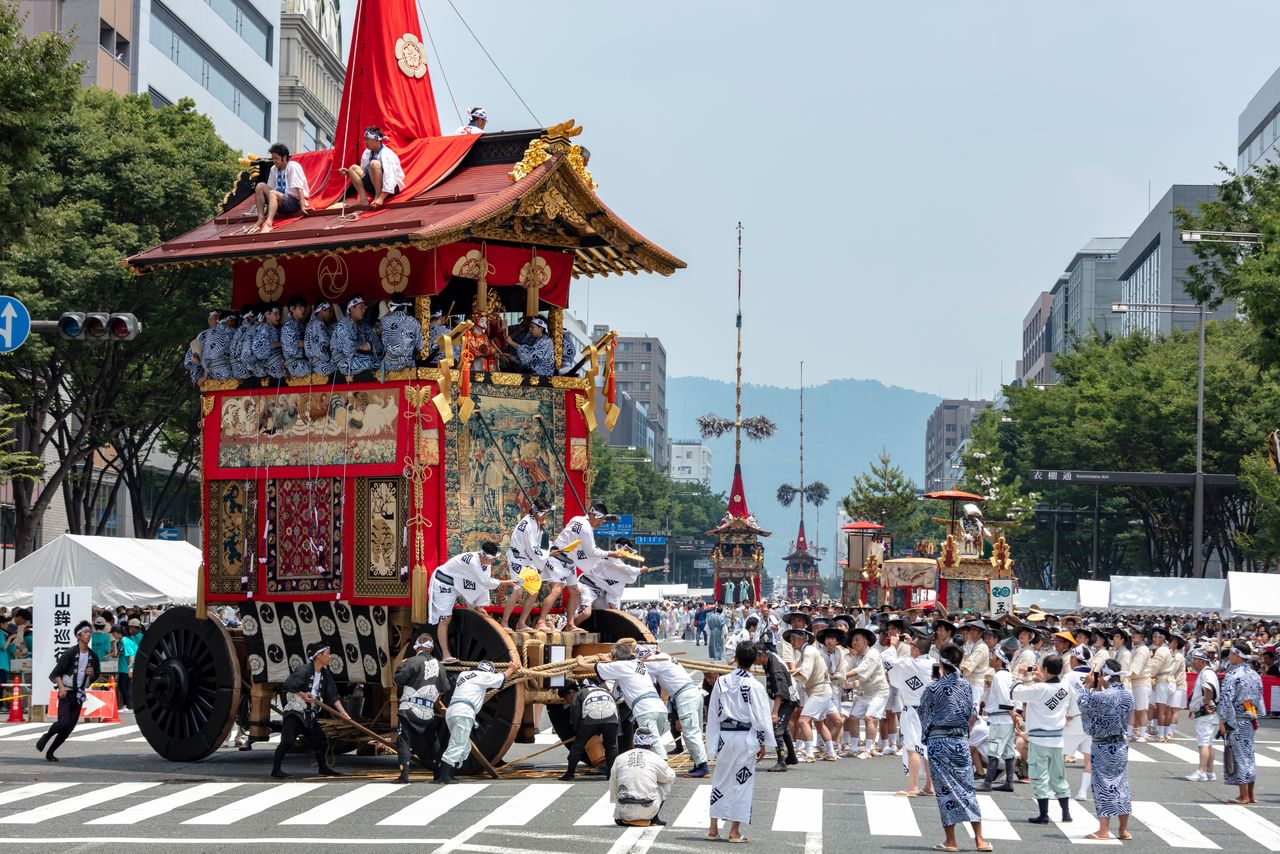
The floats have fixed wheels that can only move forward and back. To turn corners, the floats are pulled onto beds of wetted bamboo. (© Haga Library)
The highlight of the Gion Matsuri, which takes place over the entire month of July, is the stately procession of the yamahoko floats. On two separate occasions, a total of 34 ornately decorated floats are paraded through the streets of Kyoto to the omnipresent sound of the gionbayashi festival tune.
Not to be missed is the mass gathering of 23 yamahoko near the Shijō Karasuma intersection on the morning of July 17. A young child standing atop the naginataboko, which is always the lead float, cuts a thick cord to mark the start of the procession, to the cheers and applause of the crowds gathered. The tsuji mawashi, where the floats, some of which are over 20 meters tall and can weigh over 10 tons, are slid over wet bamboo to change directions at intersections, is a thrilling sight. On July 24, the remaining 11 floats take to the streets, with the boat-shaped ōfunehoko, decorated with stylized gold streamers at the prow and clad in resplendent fabric and embroidery, closing out the procession.
The floats proceed not only on the main thoroughfares but also down narrower secondary streets lined with kyō-machiya, traditional Kyoto-style dwellings. During the festival month, many of these homes display artworks, folding screens, and family treasures in their front rooms, turning the neighborhoods into a veritable street museum.
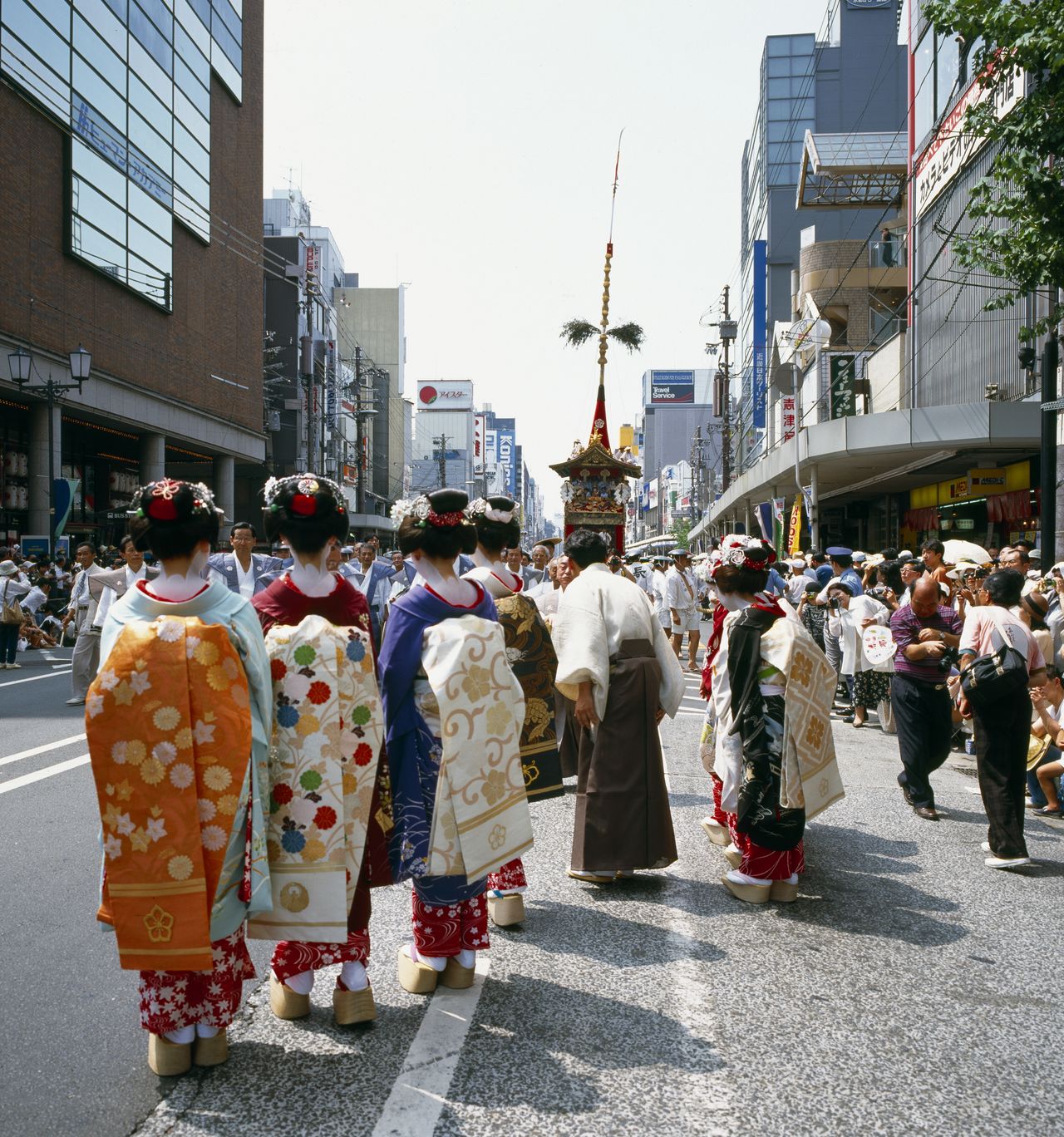
Maiko apprentice geisha await the procession. (© Haga Library)
An elegant summer event for which Kyoto is famous, this festival dates back more than 11 centuries, to when it actually began as an attempt to pacify evil spirits. The festival started in the Jōgan era (859–877), years marked by disease epidemics, a huge earthquake in the country’s northeast, and eruptions of Mount Fuji and other volcanoes around Japan. The people of Kyoto, who believed that these disasters were the work of vengeful spirits, held a ceremony called the Gion goryō-e to drive away epidemics and quell disasters, erecting 66 halberds, representing the provinces of the country at the time, in the Shinsen’en imperial palace garden.
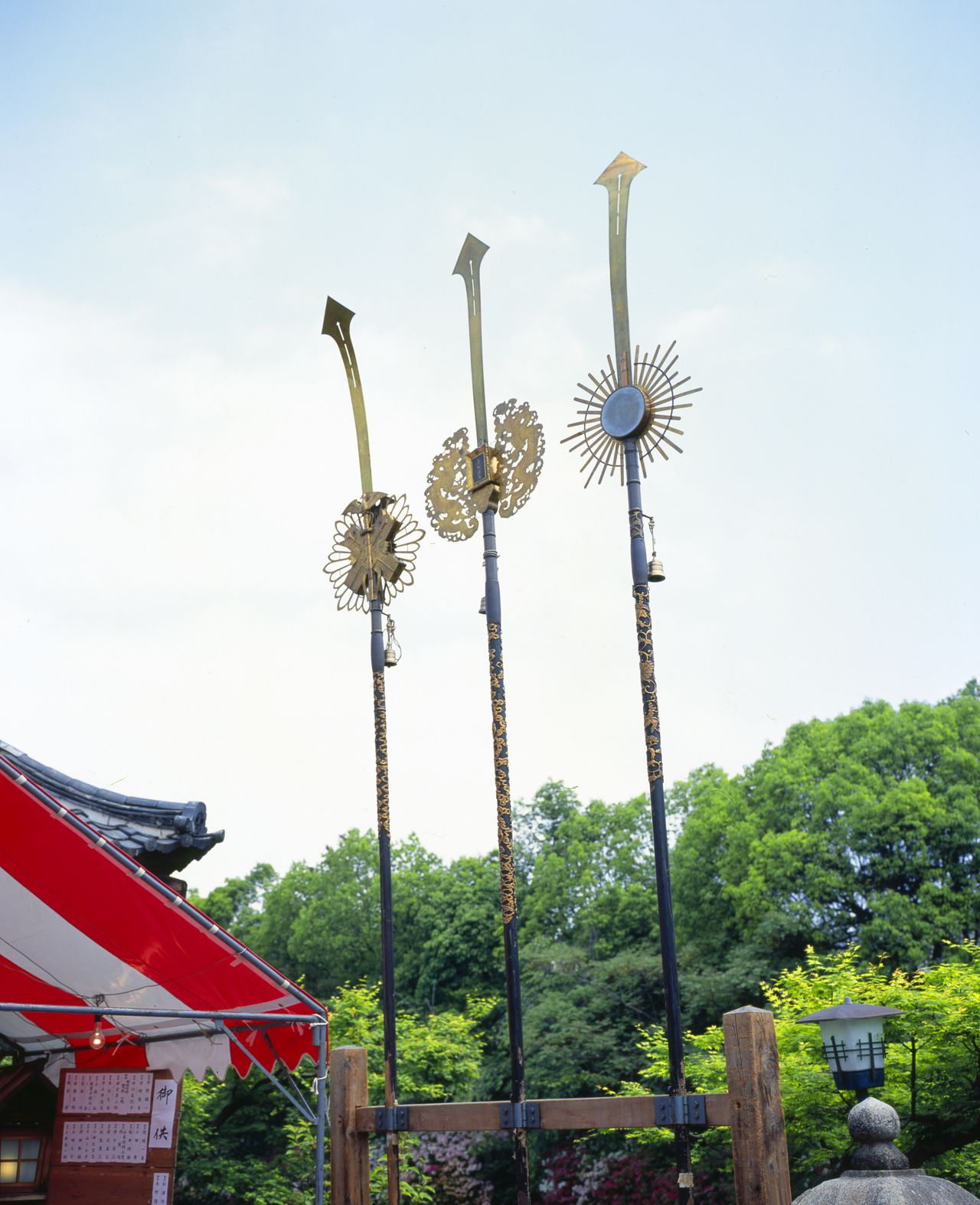
The kenhoko halberds standing in Shinsen’en. These ritual implements, which lead mikoshi portable shrine processions, are said to be the antecedents of the yamahoko. (© Haga Library)
In the goryō-e ceremony, the mikoshi of Gozu Tennō, the deity enshrined at Yasaka Shrine (known as Gion Shrine in the past), was taken on a pilgrimage through the city. Gozu Tennō, originally an Indian deity of epidemics, later evolved into a syncretic being in combination with the Shintō kami Susanoo-no-mikoto, a savage god of Japanese mythology, and attracted a fervent following. Thereafter, the populace—praying for the coming of this deity, reputed to ward off disease—began holding summer festivals throughout the country.
Tenjin Matsuri
(July 24–25, Kita-ku, Osaka)
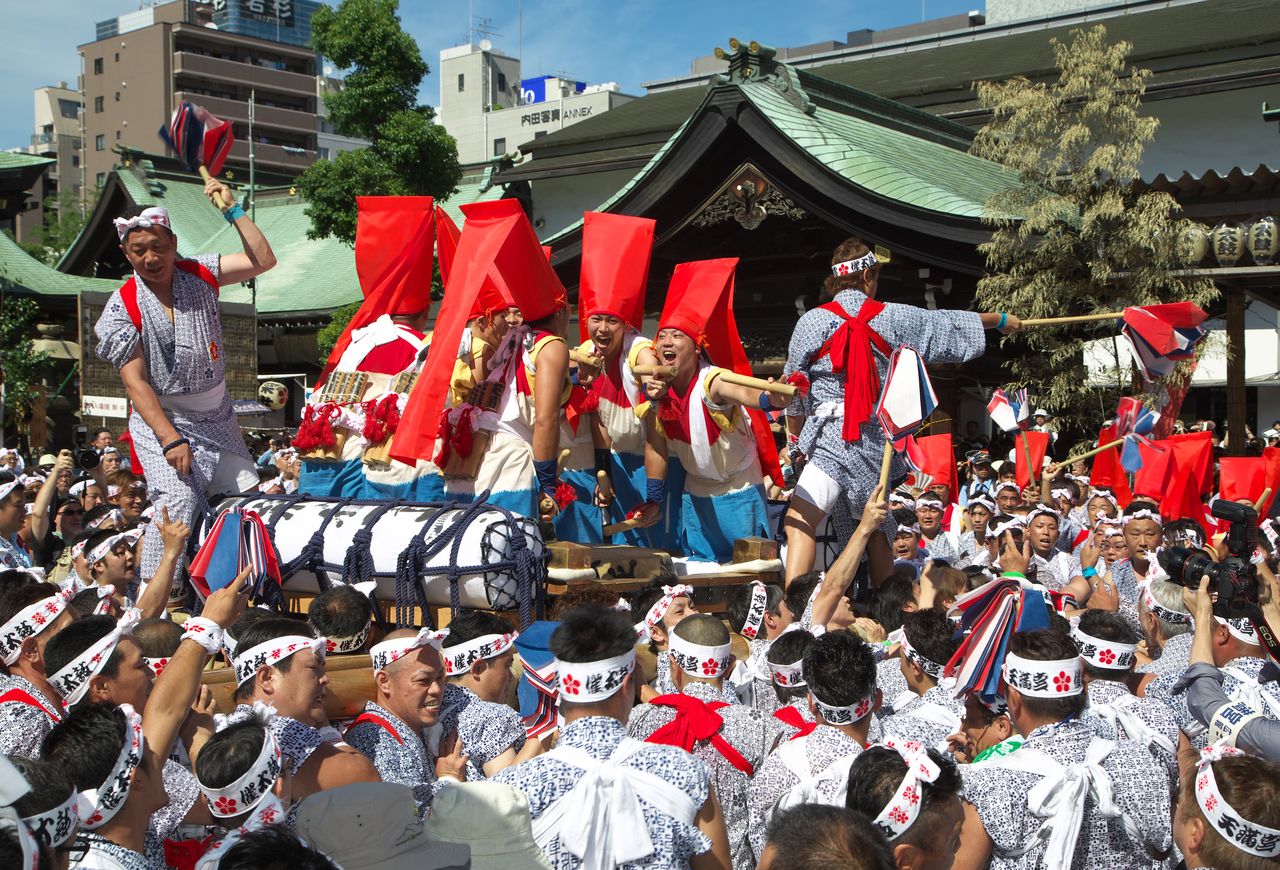
The moyooshi daiko is a festival highlight. (© Haga Library)
Tenjin-sama, as the accomplished Heian period figure Sugawara no Michizane is known, is enshrined at Tenmangū, Tenmansha, and Sugawara Jinja shrines, of which there are over 12,000 throughout Japan. Osaka’s Tenmangū is the one of the oldest, with a history of over 1,000 years. Its Tenjin Matsuri takes place every year on July 25, the day following the anniversary of Michizane’s death on July 24.
The festival has three main rituals. On the morning of July 24, a lance-floating ceremony takes place, where a child aboard a boat releases a lance into the Dōjima River. The lance’s landing place on the shore indicates the site where preparations will be made to welcome the deity.
On the following day, an imperial carriage topped with a phoenix carrying Michizane’s spirit is borne through the streets in a land procession, visiting all the parishioner neighborhoods. The festival highlight is the river procession that evening, where a boat carrying the sacred spirit is accompanied by a flotilla of nearly a hundred water craft, with a dazzling fireworks display marking the conclusion of this grand summer event.
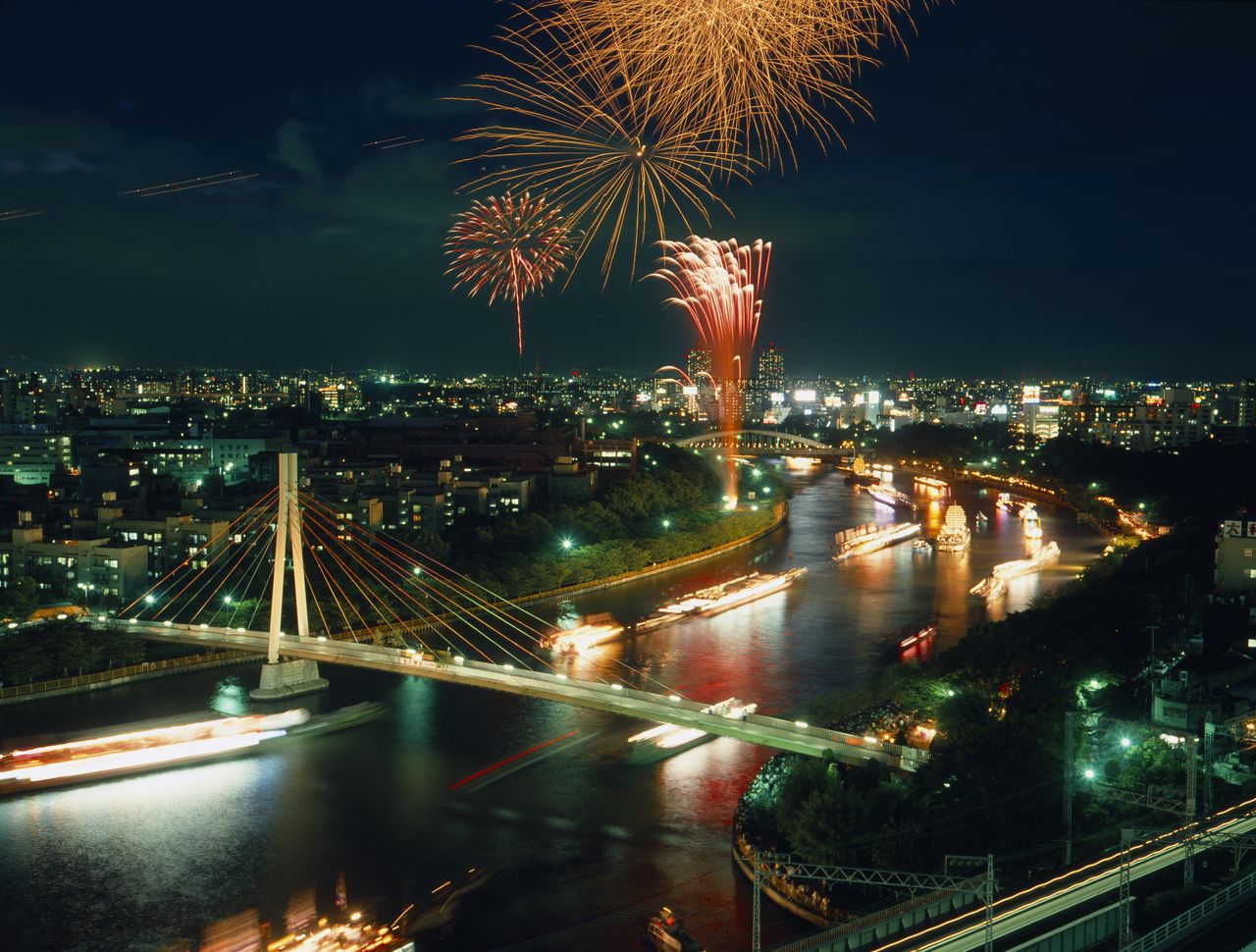
Boats, each illuminated by a bonfire, and the fireworks display along the river. (© Haga Library)
The ceremonial dances offered to deity Michizane are also fascinating. The moyooshi daiko portion of the festival features parishioners wearing tall red hats, who beat drums atop violently shaking floats. In the auspicious ryū odori dragon dance, performers twist and turn in time with the festival music, imitating a dragon rising to the heavens.
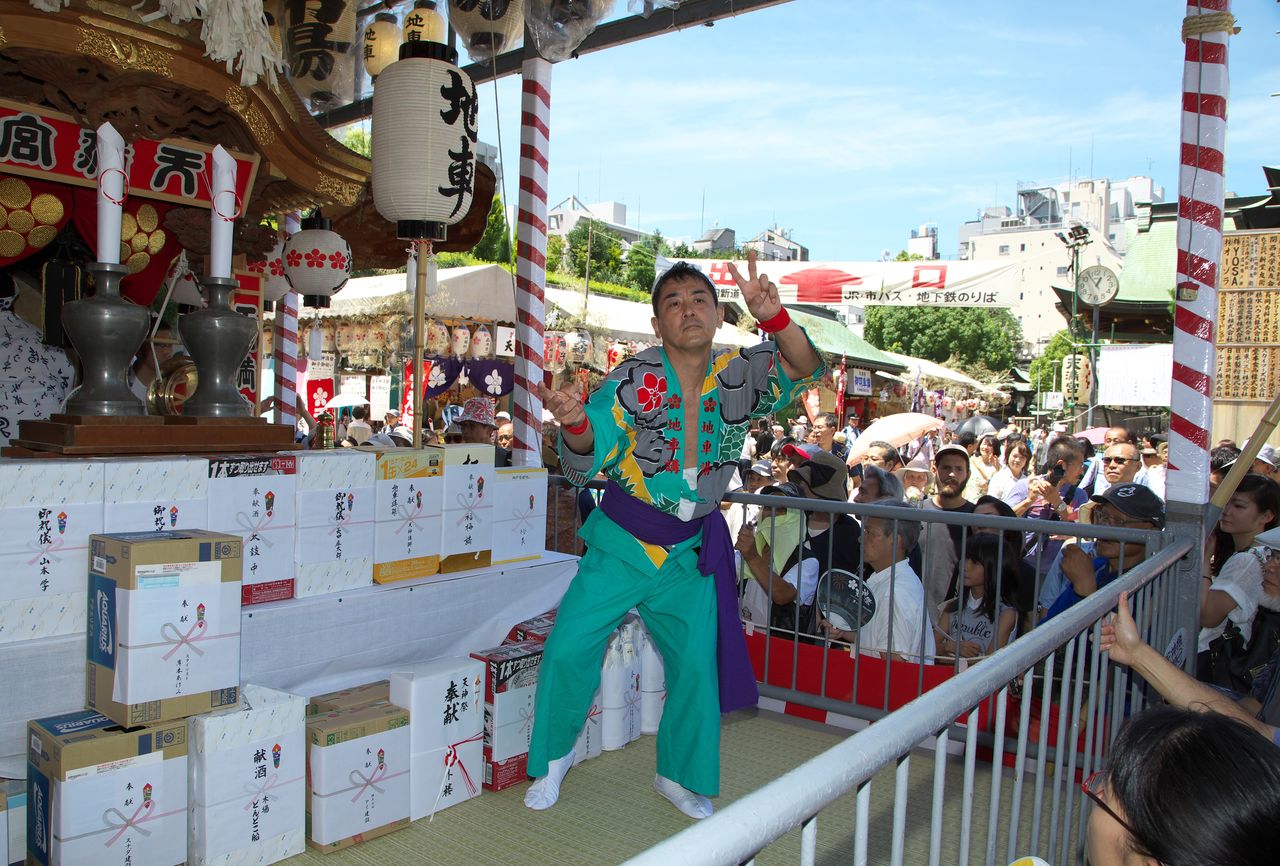
The ryū odori adds a colorful touch. (© Haga Library)
The lively Tenjin Matsuri originated to pacify the vengeful spirit of Sugawara no Michizane. Descended from a noble family, Michizane rose rapidly through the ranks at the imperial court and was eventually appointed minister of the right, one of the three most senior ranks in the imperial court. But he attracted jealousy, and Fujiwara no Tokihira (871–909), minister of the left, conspired to have him sent away to Dazaifu in faraway Kyūshū. Consumed by disappointment, Michizane died two years later, in 901.
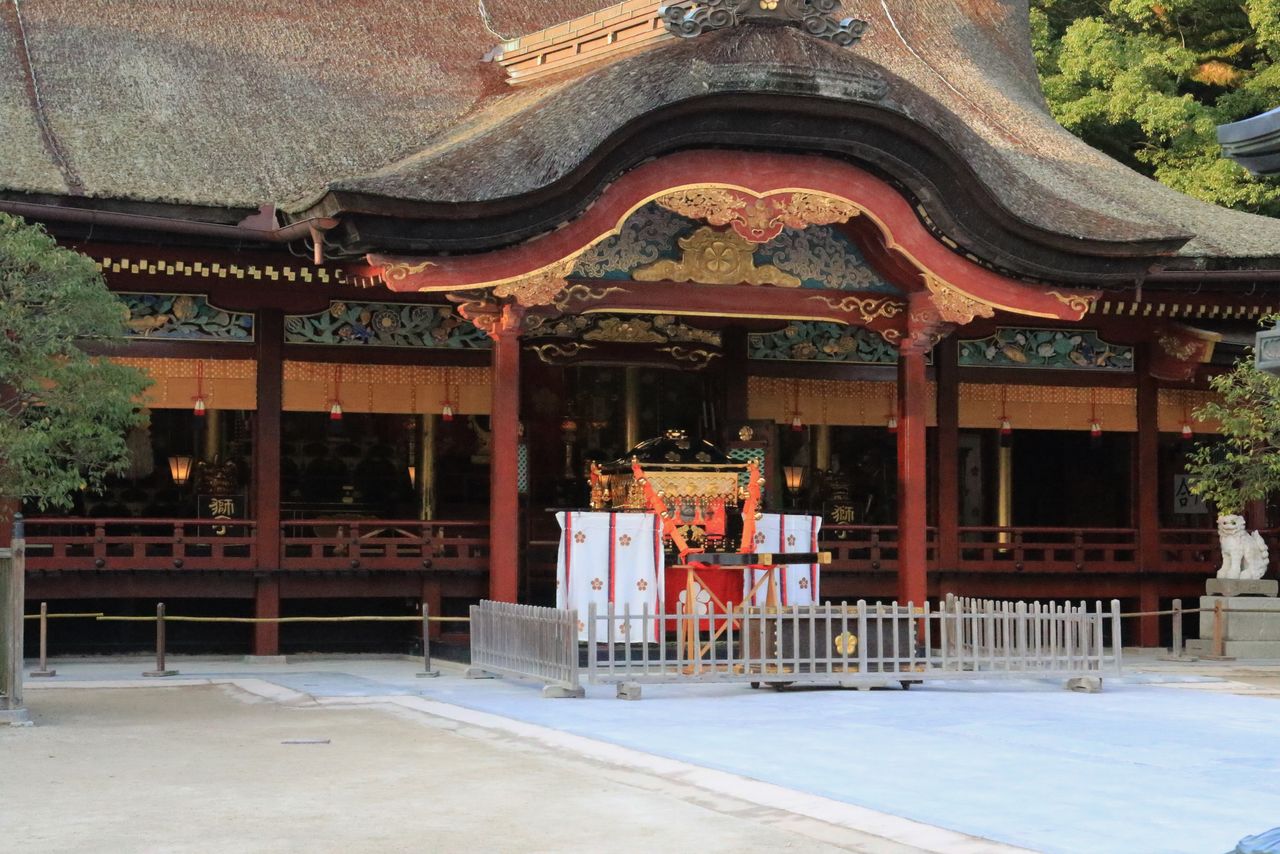
Dazaifu Tenmangū, in Dazaifu, Fukuoka Prefecture, was erected on the site of Michizane’s burial. (© Haga Library)
One calamity after another then followed. Tokihira died of illness before reaching the age of 40. Some years later, lightning struck the imperial palace in Kyoto, killing seven people, and emperor Daigo (885–930), greatly distressed by this, died soon after. Droughts and epidemics recurred, and people began to believe that these disasters were due to a curse laid by Michizane to avenge his untimely death.
To appease Michizane’s angry spirit, the imperial court ordered the construction of Kitano Tenmangū in Kyoto. Osaka Tenmangū, where Michizane had stopped on his journey into exile in Dazaifu, was also rebuilt at the same time. As the years went by, Michizane, who had been feared as a vengeful spirit, gradually came to be regarded as the deity of scholarship, the arts, and success in life, and as a protector against disasters. In modern times, students facing entrance exams flock to Tenjin shrines all over the country to pray for success.
Kanda Matsuri
(Mid-May in odd-numbered years, Chiyoda and Chūō, Tokyo)

The imperial carriages for Taira no Masakado and the other deities, ready to depart the shrine. The best spot for viewing the procession is where it leaves the shrine and heads out into the street. (© Haga Library)
The Kanda Matsuri festival of the Kanda Myōjin shrine takes place every second year in odd-numbered years, alternating with the Sannō Matsuri of Hie Shrine in Chiyoda. During the Edo period (1603–1868), both festival processions passed through Edo Castle under the gaze of the shōgun.
The Kanda Matsuri begins with the shinkōsai, where the three deities enshrined are paraded in palanquins topped with phoenixes. Large floats in the shape of a giant catfish, the supernatural yōkai spirit Shuten-dōji, and others join the procession, creating a lively atmosphere. The shrine’s parishes cover a very large area, and the procession route wends over 20 kilometers.
The second day of the festival sees nearly 200 mikoshi, large and small, from 108 neighborhoods carried into Kanda Myōjin, re-creating the joyful atmosphere of the festival in Edo times. One especially popular sight is the mikoshi from Kanda Sudachō, carried by an all-woman crew, who manage to be both exuberant and charming even while shouldering their heavy load. The festival ends when the largest mikoshi of all, the sengan mikoshi from Edo Shrine, enters the shrine precincts.
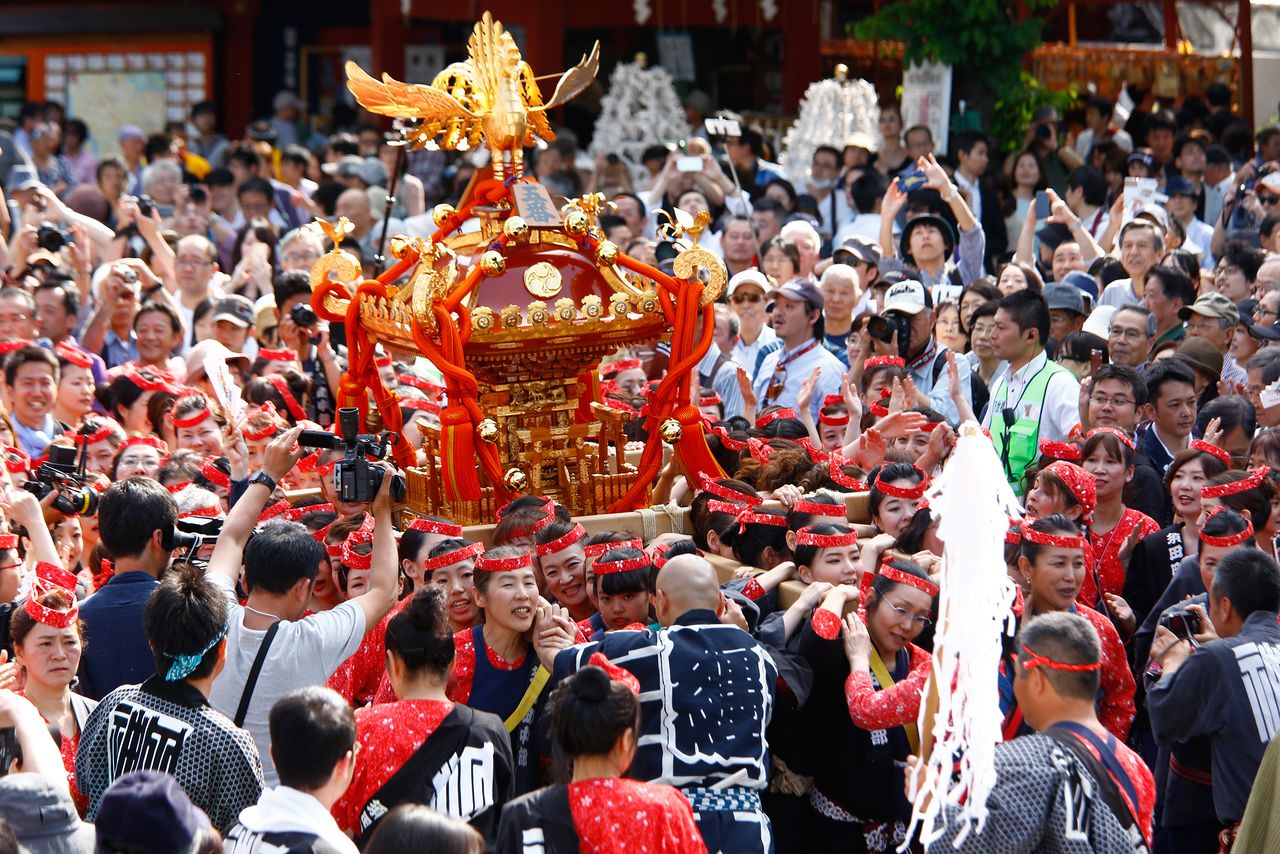
The Sudachō mikoshi, said to be the first to be carried by women. (© Haga Library)
There is a legend associated with Taira no Masakado, one of the three deities enshrined at Kanda Myōjin. A member of a powerful Kantō region family during the Heian period, Masakado styled himself the “new emperor” and attempted to gain independence for the region. Branded a rebel by the imperial court in Kyoto, he was nonetheless popular among the local people for driving out corrupt imperial officials who had imposed heavy taxes on the populace. But his rebellion was short-lived and he succumbed to an arrow in an attack by a punitive force sent from the capital.
Masakado’s head was taken to Kyoto and exposed on the riverbank, but is said to have flown back to Kantō in search of its body. There are various theories as to where the head landed, the most famous spot being in Tokyo’s prime business district of Ōtemachi, where a memorial to Masakado was erected in 1927. Epidemics in the area in the fourteenth century were believed to have been due to a curse laid by Masakado, and he was deified and enshrined at Kanda Myōjin to pacify his spirit.
In fact, the curse of Masakado lives on as an urban legend. During reconstruction after the 1923 Great Kantō Earthquake, the head’s resting place was disturbed when the land was being prepared to build a temporary structure to house the Ministry of Finance. Fourteen individuals connected with the project met untimely deaths. Similarly, when Allied occupation forces attempted to build on the site after World War II, a fatal accident occurred. Today, the Kanda Matsuri procession route includes a stop at Masakado’s memorial, where a Shintō priest intones prayers.
Japanese religious practice is unusual in that it deifies vengeful spirits and savage gods. The “big three” festivals described here gradually evolved into today’s spectacles, but their origins lie in a dark past of repeated disasters and their creation as a means of appeasing angry spirits. Being aware of this background adds an extra dimension to these colorful summertime events.
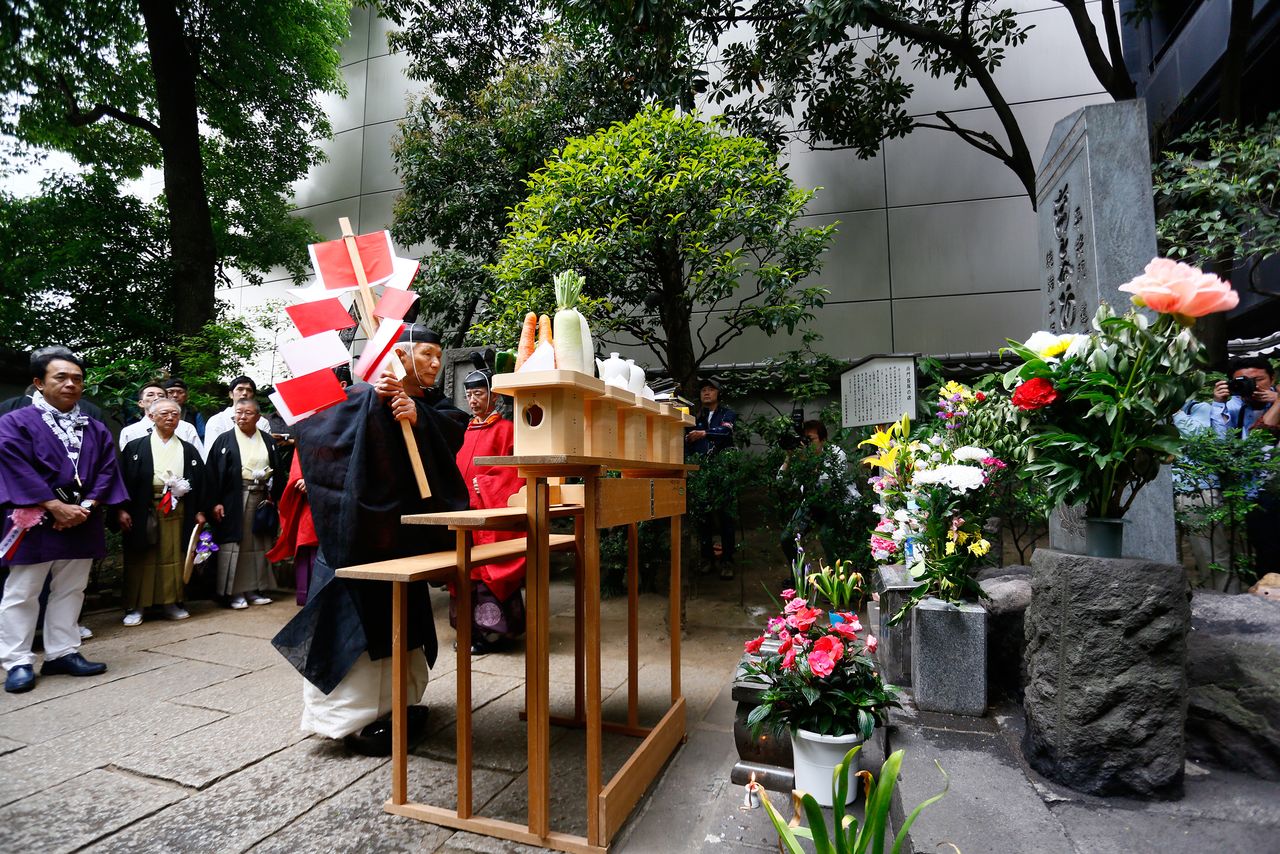
The ceremony at the memorial to Taira no Masakado. (© Haga Library)
(Originally published in Japanese. Dates given are those on which the festivals are usually held. Banner photo: Moyooshi daiko drummers at Osaka’s Tenjin Matsuri. © Haga Library.)
Kyoto Osaka Tokyo festival Shintō Tenjin Matsuri matsuri Gion Matsuri Kanda Matsuri